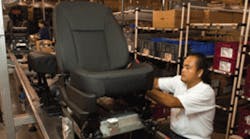Is your company giving ergonomics, described by the Occupational Safety and Health Administration as "the science of fitting workplace conditions and job demands to the capabilities of the working population," the attention it deserves?
Failure to do so could be costly. Ergonomics-related injuries are the leading cause of serious non-fatal workplace injuries, according to the 2011 Liberty Mutual Workplace Safety Index. Indeed, overexertion injuries -- caused by excessive lifting, pushing, pulling, holding and carrying -- grabbed the No. 1 spot (based on 2009 data, the latest year for which data were available) in dollar terms, costing businesses $12.75 billion in direct costs. Add repetitive-motion injuries to the calculation, and the cost increases by another $1.97 billion.
Jeff Sanford, managing consultant at Humantech, says ergonomics typically has not received enough consideration by businesses. "You need to manage ergonomics as a process," just as you would any other system in the organization, he says.
The ergonomics consulting firm suggests that leadership for the ergonomics process should be assigned to engineering or operations, and the reason is simple: Engineering and operations most influence workstation design and equipment. "All sustainable and preferred improvements are engineering controls rather than work- practice controls or administrative controls," points out James Mallon, Humantech vice president. He and Sanford shared their views during a 2011 online seminar.
One manufacturing company that has recognized the importance of ergonomics is Magna International. In 2007 the automotive supplier launched a robust ergonomics program in North America. The program includes five measurable categories: support infrastructure; analysis and prioritization; implementation and risk reduction; proactive ergonomics; and metrics and communication.
Each category then has five to six criteria elements that outline the specific requirements with which a participating facility must comply. For example, one criterion is that a facility must have an ergonomics committee, and the committee must be led by the engineering manager.
The ergonomics effort in 2011 grabbed the attention of safety officials in Michigan, where the program has been embraced by 14 Magna International plants. The Michigan Occupational Safety and Health Administration presented Magna with its Ergonomic Innovation Award.
Says Marc Neeb, Magna International executive vice president of human resources: "The program has unquestionably been positive for our organization and specifically our employees through benefits such as reduced injuries and increased productivity and quality."





